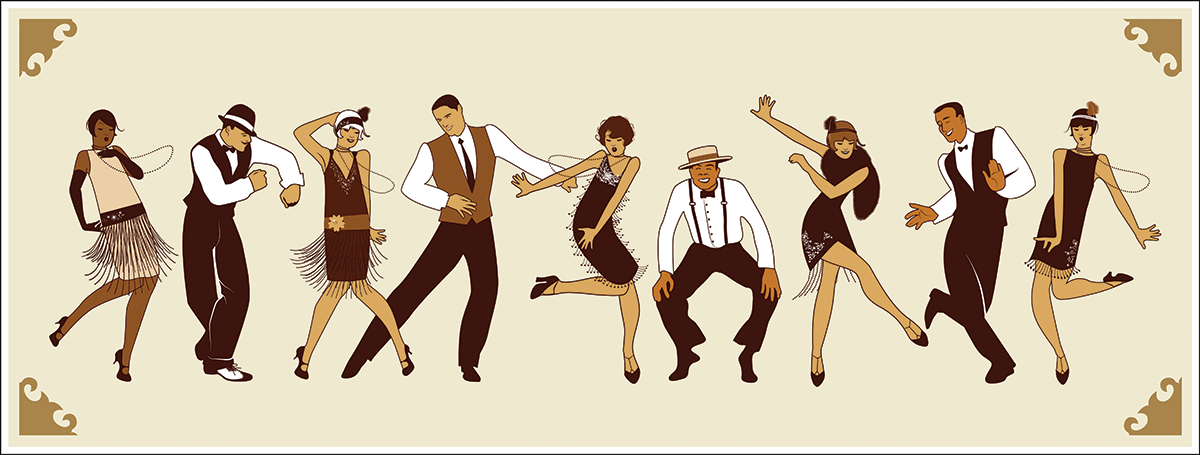An Era of Change
TYBA
2020-21
-Osho
The 19th century 'poised' and 'civilised' American society dissipated after World War I. With the dawn of the 20th century, the common masses gained momentum and questioned the lopsided status-quo prevailing in their 'ideal' society. The horrors of the war and the subsequent Spanish Flu pandemic of 1918 ingrained in the minds of the young Americans that life is too short to be surrounded by troubles, instead one should enjoy all that life had to offer and live it to the fullest without worrying of the future.
Meanwhile, jazz musicians from New Orleans migrated to various parts of America and popularized the new music genre. With time, jazz appealed to the American society as it proved as a medium for the white middle class to imbibe the African-American values. For the first time in American history, what was previously considered "bottom culture" rose to the top and became a highly desired commodity in every echelon of the society.
The pine for a transmogrification in the existing social setup also touched the women of America. Frederick Allen once stated that, "Women were the guardians of morality; they were made of finer stuff than men and were to act accordingly." This was a commonly accepted view of the American women which entangled them in their traditional gender role sets. With the jazz age gripping America, women started envisioning this cultural rebellion as an outlet for their own liberation. It invigorated a sense of individuality in them, by revamping their familial constructs.
Modern feminism bloomed and women started playing an important role in society. Mass production and expanding media allowed women of diverse backgrounds to access new styles and activities that were dramatically different from those of their mothers’ generations. The women shed their conservative and modest outlook to embrace the bold fashion statements of the flappers.
Flappers were a significant cultural symbol of the Jazz Age and the roaring twenties. The term "flapper" was used to describe the new women of the 1920s who bobbed their hair, wore short skirts, danced their hearts out and consumed alcohol. They eliminated the body hugging corsets and replaced them with danceable, free flowing and shorter waistline dresses. With a newfound comfort in clothing, the women threw themselves on the dancefloor and embraced their freedom of movement.
Furthermore, mass media, marketing, and production encouraged women of diverse economic backgrounds to push the traditional boundaries of womanhood, reshaping the American society along the way. An array of job opportunities opened up for women in performing arts, radio shows, clothing and cosmetic industries, advertising, etc. In fact, Jazz clubs, speakeasies, and stage shows were encouraged to have flappers employed at these establishments, in order to appeal to the "liberated" youth culture.
The women's suffrage movement, a decades-long fight to win the right to vote for women in the United States, also gained momentum during the roaring 1920s. Finally, with the ratification of the 19th Amendment to the Constitution on 18th August 1920, women were bestowed with the right to vote. Thus, with a paraphernalia of freedoms available to them, the women of America were empowered to dismantle the conservative society of their parents and grandparents.
The independent American women made inroads in the consumer market. They lavishly spent on purchasing cosmetics, jewelry, fashion magazines, music instruments, cars, clothing, etc. They danced their heart out, wore bold and glamorous outfits, consumed alcohol and indulged in merry making.
The party stopped when the economy crashed and the Great Depression curtailed the night life. Although the flapper lifestyle died along with the Roaring Twenties, the freedoms women tasted in that era were not easily given up. The spark of freedom that the roaring twenties and the jazz age ignited in the lives of American women was never meant to die.
Thus, the Jazz age, led to the birth of a new America wherein a carefree and independent woman living life on her own terms became the new normal.
References:
https://courses.lumenlearning.com/boundless-ushistory/chapter/a-culture-of-change/
https://www.d.umn.edu/cla/faculty/tbacig/studproj/is3099/jazzcult/20sjazz/jazzlib.html
https://wams.nyhistory.org/confidence-and-crises/jazz-age/
https://thesocietypages.org/socimages/2013/03/25/guest-post-the-rise-of-the-flapper/





Comments
Post a Comment